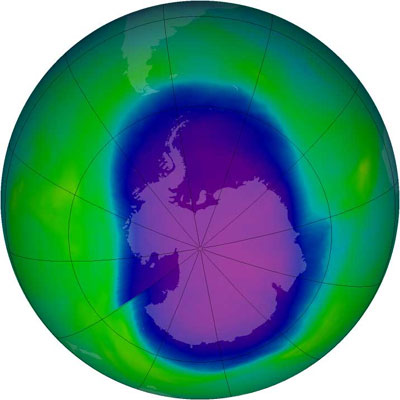The phenomenon of ozone hole may no longer be limited to Antarctic zone alone as a NASA-led study has found an unprecedented depletion of the ozone layer above the Arctic too for the first time this year.
 Over most of Antarctic, there is a sharp decline in the total ozone during spring every year in the Southern Hemisphere. This phenomenon is known as "Springtime Antarctic ozone hole", and it came into being in the 1980s. Most of the ozone in the Earth's atmosphere is found in the region called the stratosphere. The stratospheric ozone layer, extending from about 10 to 20 miles (15 to 35 kilometers) above the surface, protects life on Earth from the sun's harmful ultraviolet rays. A depletion in ozone increases the amount of solar ultraviolet radiation reaching the ground, which has several harmful effects like - an increase in the incidence of skin cancer, higher incidence of cataracts, suppression of immune systems in organisms, adverse impact on crops and animals and some climatic effect, to name a few. Scientists from 19 institutions in nine countries namely, United States, Germany, The Netherlands, Canada, Russia, Finland, Denmark, Japan and Spain, who investigated the ozone loss in Arctic have found that the amount of ozone destroyed in the Arctic in early 2011 was for the first time comparable to that in the Antarctic ozone hole. The conclusions of the scientists were based on an analysis of a comprehensive set of measurements including, daily global observations of trace gases and clouds from NASA's Aura and CALIPSO spacecraft; ozone measured by instrumented balloons; meteorological data and atmospheric models.
The unusually long spell of cold conditions in the Arctic lower stratosphere has been attributed to the unprecedented ozone loss, which exceeded 80 per cent over 18-20 kilometres altitude. The cold conditions trigger the formation of polar stratospheric clouds, or PSCs, converting the inactive chlorine and bromine reservoirs to more active forms that chemically obliterate ozone. The scientists said that further studies are needed to determine what factors caused the cold period to last so long and that it is currently impossible to predict when such severe Arctic ozone depletion will occur. According to Gloria Manney of NASA's Jet Propulsion Laboratory in Pasadena, California, the ability to quantify polar ozone loss and associated processes will be reduced in future when NASA's Aura and CALIPSO spacecraft, whose trace gas and cloud measurements were central to the study, reach the end of their operational lifetimes. He added that it is imperative to maintain the capability if future ozone loss is to be reliably predicted.
Ozone is depleted by gases containing chlorine or bromine emitted from certain industrial processes and consumer products, which use CFCs (chlorofluorocarbons) and HCFCs (hydrochlorofluorocarbons). In 1989, an international treaty known as Montreal Protocol was signed to protect the ozone layer by phasing out substances that deplete the ozone layer.
MOST POPULAR IN LAST 24 HRS
MOST POPULAR IN LAST 7 DAYS
|